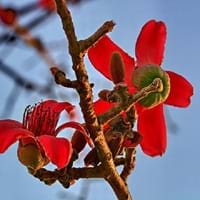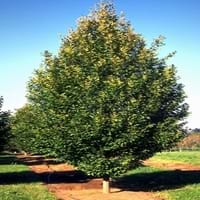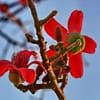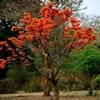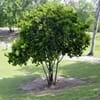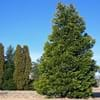Life Span
Perennial
Perennial
Origin
Southern Asia, Southeastern Asia, India, China, Melanesia, Australia
Europe, Eastern Europe, Southern Europe, Western Europe, Turkey
Types
Ceiba casearia, Bombax pentandrum
Not Available
Number of Varieties
Not Available
Habitat
Tropical regions
Hedge, Woodland Garden Canopy
USDA Hardiness Zone
9-15
4-8
Sunset Zone
H1, H2, 20, 21, 22, 23, 24
2a, 2b, 3a, 3b, 4, 5, 6, 7, 8, 9, 14, 15, 16, 17
Habit
Oval or Rounded
Oval or Rounded
Flower Color
Red, Orange Red
Yellow, Green
Flower Color Modifier
Bicolor
Bicolor
Fruit Color
Brown
Yellow, Green, Brown
Leaf Color in Spring
Green
Green, Light Green
Leaf Color in Summer
Green
Green, Dark Green
Leaf Color in Fall
Green
Yellow, Yellow green, Orange Red
Leaf Color in Winter
Not Available
Not Available
Leaf Shape
Palmate
Ovate and toothed
Plant Season
Spring, Summer, Fall, Winter
Summer, Fall, Winter
Sunlight
Full Sun
Full Sun, Partial Sun, Partial shade
Type of Soil
Loam, Sand
Clay, Loam
The pH of Soil
Acidic, Neutral
Acidic, Neutral
Soil Drainage
Well drained
Average
Bloom Time
Early Spring, Late Winter
Spring
Tolerances
Drought
Pollution, Drought
Where to Plant?
Ground
Ground
How to Plant?
Seedlings
Seedlings
Plant Maintenance
Medium
Medium
Watering Requirements
Average Water Needs
Requires regular watering
In Summer
Moderate
Lots of watering
In Spring
Moderate
Moderate
In Winter
Average Water
Average Water
Soil pH
Acidic, Neutral
Acidic, Neutral
Soil Type
Loam, Sand
Clay, Loam
Soil Drainage Capacity
Well drained
Average
Sun Exposure
Full Sun
Full Sun, Partial Sun, Partial shade
Pruning
Prune when young, Remove dead branches
Remove dead or diseased plant parts
Fertilizers
Nitrogen
All-Purpose Liquid Fertilizer
Pests and Diseases
Bacterial leaf spot, Red blotch, Root rot
Aphids, Coral Spot, Powdery mildew
Plant Tolerance
Drought, Soil Compaction
Drought
Flowers
Showy
Insignificant
Flower Petal Number
Single
Not Available
Foliage Texture
Coarse
Medium
Foliage Sheen
Glossy
Glossy
Attracts
Bees, Birds, Hummingbirds
Caterpillar, Not Available
Allergy
Headache, Pulmonary oedema, Respiratory distress, wheezing
Pollen
Aesthetic Uses
Not Used For Aesthetic Purpose
Bonsai
Beauty Benefits
Improve skin tone, Making cosmetics, Moisturizing, Skin irritation
Not Available
Environmental Uses
No fertilizer, pesticides, or herbicides needed, Prevent Soil Erosion, soil stabilisation
Air purification
Medicinal Uses
Aphrodisiac, Diuretic
Bach, Haemostatic, Ophthalmic
Part of Plant Used
Leaves, Seeds
Bark, Leaves, Wood
Other Uses
Oil is used as an industrial solvent, Used as Ornamental plant
Used as fuel, Used to make yellow dye
Used As Indoor Plant
No
Yes
Used As Outdoor Plant
Yes
Yes
Garden Design
Feature Plant, Shade Trees, Tropical
Feature Plant, Hedges, Screening / Wind Break, Shade Trees, Street Trees
Botanical Name
Ceiba pentandra
CARPINUS betulus
Common Name
Cotton Tree, Red Kapok, Red-silk-cotton Tree
European Hornbeam
In Hindi
सफ़ेद सेमल / शाल्मली
European Hornbeam
In German
Kapok baum
Hainbuche
In French
Fromager
Hornbeam européenne
In Spanish
Ceiba
Europeo carpe
In Greek
Ceiba
Ευρωπαϊκή Γαύρος
In Portuguese
Mafumeira
Carpino Europeia
In Polish
Puchowiec pięciopręcikowy
Europejski Grab
In Latin
Ceiba
Carpinus betulus
Phylum
Magnoliophyta
Magnoliophyta
Class
Magnoliopsida
Magnoliopsida
Family
Bombacaceae
Betulaceae
Clade
Eudicots, Rosids
Angiosperms, Eudicots, Rosids
Tribe
Not Available
Carpineae
Subfamily
Not Available
Coryloideae
Number of Species
Not Available
Importance of Kapok and European Hornbeam
Want to have the most appropriate plant for your garden? You might want to know the importance of Kapok and European Hornbeam. Basically, these two plants vary in many aspects. Compare Kapok and European Hornbeam as they differ in many characteristics such as their life, care, benefits, facts, etc. Every gardener must at least have the slightest clue about the plants he wants to plant in his garden. Compare their benefits, which differ in many ways like facts and uses. The medicinal use of Kapok is Aphrodisiac and Diuretic whereas of European Hornbeam is Bach, Haemostatic and Ophthalmic. Kapok has beauty benefits as follows: Improve skin tone, Making cosmetics, Moisturizing and Skin irritation while European Hornbeam has beauty benefits as follows: Improve skin tone, Making cosmetics, Moisturizing and Skin irritation.
Compare Facts of Kapok vs European Hornbeam
How to choose the best garden plant for your garden depending upon its facts? Here garden plant comparison will help you to solve this query. Compare the facts of Kapok vs European Hornbeam and know which one to choose. As garden plants have benefits and other uses, allergy is also a major drawback of plants for some people. Allergic reactions of Kapok are Headache, Pulmonary oedema, Respiratory distress and wheezing whereas of European Hornbeam have Pollen respectively. Having a fruit bearing plant in your garden can be a plus point of your garden. Kapok has showy fruits and European Hornbeam has no showy fruits. Also Kapok is not flowering and European Hornbeam is not flowering . You can compare Kapok and European Hornbeam facts and facts of other plants too.
